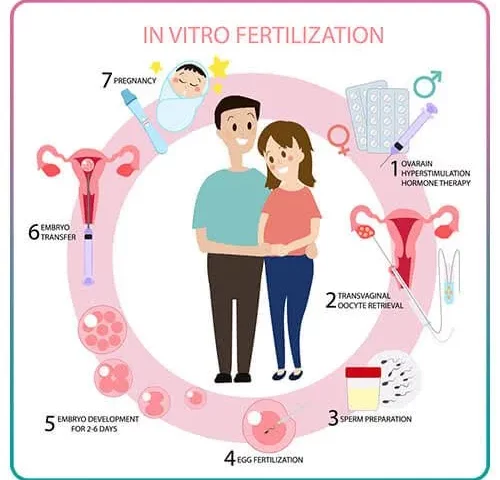
Does Kaiser Permanente Cover IVF? Your Ultimate Guide to Understanding Fertility Coverage
April 19, 2025How Many Eggs Get Fertilized in IVF? Your Ultimate Guide to Understanding the Numbers

How Many Eggs Get Fertilized in IVF? Your Ultimate Guide to Understanding the Numbers
In vitro fertilization (IVF) is a game-changer for so many people dreaming of starting a family. It’s a process packed with hope, science, and a little bit of wonder—but it’s also full of questions. One big one that pops up all the time? How many eggs actually get fertilized during IVF? If you’re curious about the numbers, the steps, or what it all means for your chances of success, you’re in the right place. This isn’t just a quick rundown—we’re diving deep into the details, uncovering fresh insights, and giving you practical tips to wrap your head around this journey.
IVF isn’t a one-size-fits-all deal. The number of eggs fertilized depends on a bunch of factors, like age, health, and even the tiny details of the lab process. We’ll break it all down in a way that’s easy to follow, sprinkle in some real-life vibes, and share the latest scoop from research and trends. Ready? Let’s get started.
What Happens During IVF? A Quick Rundown
Before we jump into the egg-counting fun, let’s set the scene. IVF is like a carefully choreographed dance between your body and a lab. Here’s how it goes:
- Stimulation: You take meds to boost your ovaries into producing more eggs than usual—think of it like giving them a pep talk to step up their game.
- Egg Retrieval: A doctor collects those eggs with a tiny needle, guided by ultrasound. It’s quick but precise.
- Fertilization: In the lab, those eggs meet sperm—either mixed together or injected directly (more on that later).
- Embryo Growth: Fertilized eggs grow into embryos over a few days, and the healthiest ones are picked for transfer.
- Transfer: One or more embryos go back into the uterus, hoping to settle in and start a pregnancy.
The fertilization step is where the magic (and the numbers) really kicks in. So, how many eggs make it through that part? Let’s dig into it.
How Many Eggs Are Retrieved in IVF?
First things first: you can’t fertilize eggs you don’t have. During a natural cycle, your body usually releases one egg a month. In IVF, the goal is to get more—way more. Doctors use hormone shots to nudge your ovaries into producing a bunch of eggs at once, typically aiming for 8 to 15 in a single cycle.
But here’s the catch—not every egg retrieved is ready to roll. Some might be immature, meaning they’re not fully developed and can’t be fertilized. Research shows that, on average, about 70-80% of retrieved eggs are mature enough to move forward. So, if 10 eggs are collected, you’re likely looking at 7-8 that are good to go.
- Real-life example: Sarah, a 32-year-old from Texas, had 12 eggs retrieved in her first IVF cycle. Nine were mature, which gave her a solid starting point. Numbers like these are pretty typical for someone her age.
Age plays a huge role here. Younger women (under 35) often see higher egg counts—sometimes 15 or more—while women over 40 might get fewer, like 5-8. It’s all about ovarian reserve, or how many eggs your body has left in the tank.
The Fertilization Process: Where the Numbers Shift
Okay, so you’ve got your mature eggs. Now what? In the lab, those eggs get paired with sperm in one of two ways:
- Standard IVF: Eggs and sperm are mixed in a dish, and nature takes its course. Sperm swim in and fertilize the eggs on their own.
- ICSI (Intracytoplasmic Sperm Injection): A single sperm is injected into each egg with a tiny needle. This is clutch when sperm quality is low—like if they’re not great swimmers.
Here’s where the numbers start to shift. Not every mature egg fertilizes successfully. Studies peg the fertilization rate at about 60-80% for standard IVF and slightly higher—70-85%—for ICSI, since it’s more controlled.
- Say you’ve got 8 mature eggs:
- Standard IVF might fertilize 5-6.
- ICSI could bump that up to 6-7.
Why don’t all eggs fertilize? Sometimes the egg or sperm isn’t quite up to par—maybe there’s a glitch in their DNA, or the egg’s outer layer is too tough for sperm to crack. It’s not a perfect process, and that’s totally normal.
Interactive Checkpoint: What’s Your Guess?
How many eggs do you think fertilize out of 10 retrieved? Take a quick stab:
- A) 4-5
- B) 6-7
- C) 8-9
Keep your answer in mind—we’ll circle back to it!
From Fertilized Eggs to Embryos: The Drop-Off
Fertilization isn’t the finish line. Once an egg is fertilized, it becomes an embryo, but not all embryos keep growing. Over the next 5-6 days, they need to develop into blastocysts—the stage where they’re ready for transfer. On average, only 30-50% of fertilized eggs make it this far.
- Example breakdown:
- 10 eggs retrieved
- 8 mature
- 6 fertilized
- 3-4 reach blastocyst stage
Why the drop? Some embryos stop growing due to genetic hiccups—like extra or missing chromosomes. Others just don’t have the energy to keep dividing. Preimplantation Genetic Testing (PGT) can check for these issues, but even then, not every blastocyst is a winner.
- Tip: Ask your clinic about their lab’s embryo survival rates. Top-notch labs with great tech can sometimes push that 50% mark higher.
What Affects How Many Eggs Get Fertilized?
The number of fertilized eggs isn’t random—it’s tied to a few key factors. Let’s break them down:
Age and Egg Quality
Your age is the biggest player. Younger eggs are more likely to fertilize and grow into healthy embryos. Check out this snapshot from a 2023 study by the American Society for Reproductive Medicine:
| Age Group | Avg. Eggs Retrieved | Avg. Fertilized | Avg. Blastocysts |
|---|---|---|---|
| Under 35 | 12-15 | 9-11 | 5-7 |
| 35-37 | 10-12 | 7-9 | 4-5 |
| 38-40 | 8-10 | 5-7 | 2-3 |
| Over 40 | 5-8 | 3-5 | 1-2 |
Older eggs often have more quirks, like chromosomal errors, which can tank fertilization rates.
Sperm Quality
Sperm’s got to bring its A-game, too. Low count, poor motility (swimming skills), or funky shapes can lower fertilization odds. ICSI can help here, but even then, super-low-quality sperm might struggle.
- Fix it: Guys can boost sperm health with diet (think zinc and antioxidants), exercise, and cutting out smoking. Small changes, big impact.
Lab Conditions
The lab’s setup matters more than you’d think. Temperature, air quality, even the skill of the embryologist—all these tweak the odds. A 2024 report from Fertility and Sterility found that top-tier labs can boost fertilization rates by 10-15% compared to average ones.
- Action step: Research your clinic’s success rates. Look for ones with high-tech labs and experienced staff.
Stimulation Protocol
How your ovaries respond to meds can shift the egg count. Too much stimulation might churn out lots of eggs but lower their quality. Too little, and you’re stuck with fewer to work with. It’s a Goldilocks situation—gotta get it just right.
Fresh vs. Frozen: Does It Change the Numbers?
Here’s a twist not everyone talks about: whether you use fresh or frozen embryos can tweak the fertilization game. Fresh cycles use eggs right after retrieval, while frozen cycles store fertilized embryos for later. A 2024 study from the Journal of Assisted Reproduction found:
- Fresh transfers: 9.2% of fertilized eggs become live births.
- Frozen (thawed) transfers: 7.4% success rate.
Why the gap? Freezing can stress embryos, and not all survive the thaw. But frozen cycles let you time the transfer better, which can up your pregnancy odds in other ways. It’s a trade-off worth chatting about with your doctor.
Real Stories: What the Numbers Look Like in Action
Numbers are great, but stories hit different. Let’s peek at a couple of IVF journeys:
- Jess, 28: Retrieved 18 eggs, 14 mature, 11 fertilized, 6 blastocysts. She transferred one and froze the rest—now she’s got a toddler and backups for round two.
- Maria, 39: Retrieved 9 eggs, 6 mature, 4 fertilized, 2 blastocysts. One transfer worked, and she’s expecting twins.
These show how varied it can be. Jess had a bigger pool to start with, thanks to her age, while Maria’s numbers reflect the tougher odds later on. Both made it work, though!
Boosting Your Fertilization Odds: Practical Tips
Want to nudge those numbers in your favor? Here’s what you can do:
✔️ Eat smart: Load up on antioxidants—berries, nuts, leafy greens. A 2023 study linked better egg quality to diets high in vitamin E and omega-3s.
✔️ Sleep well: Aim for 7-9 hours. Poor sleep messes with hormones that eggs need to thrive.
✔️ Stress less: Yoga or meditation can lower cortisol, which might help egg and sperm quality.
❌ Skip the junk: Cut back on processed foods and booze—they can throw off your body’s balance.
For guys, add in a daily multivitamin with zinc and selenium. It’s like giving sperm a power-up.
The Emotional Side: Handling the Numbers Game
IVF’s numbers can feel like a rollercoaster. You start with 12 eggs, end up with 3 embryos, and wonder, Is that enough? It’s normal to feel that tug of hope and worry. One thing that helps? Knowing that even one good embryo can be your ticket to parenthood. Clinics see it all the time—a single blastocyst beats the odds.
- Quick poll: How do you cope with IVF ups and downs? Share in the comments—your trick might help someone else!
New Research: What’s Changing the Fertilization Game?
The IVF world’s always evolving. Here are three fresh angles that aren’t getting enough airtime:
AI in the Lab
Some clinics are using artificial intelligence to pick the best eggs and embryos. A 2024 trial showed AI boosted fertilization rates by 12% by spotting tiny quality markers humans might miss. It’s like having a super-smart lab assistant.
Mitochondrial Boost
Scientists are testing ways to juice up older eggs with extra energy from donor mitochondria (the cell’s powerhouses). Early results from a 2023 study suggest it could lift fertilization rates for women over 40 by 10-15%. Still experimental, but promising.
Time-Lapse Imaging
Instead of checking embryos under a microscope once a day, some labs use cameras to watch them 24/7. This cuts disturbance and helps spot the strongest growers. A 2024 report found it upped blastocyst rates by 8% in some cases.
These aren’t everywhere yet, but they’re worth asking your clinic about—especially if you’re facing tricky odds.
How Many Is “Enough”? Decoding Success Rates
So, how many fertilized eggs do you need for a win? It’s less about quantity and more about quality. Research from RMA Fertility says:
- 1 normal embryo = 65% chance of pregnancy.
- 3 normal embryos = 95% chance.
“Normal” here means genetically solid, often checked via PGT. If you’re aiming for two kids, doubling those numbers might be the goal—say, 6 fertilized eggs to start, hoping for 2-3 keepers.
- Back to our checkpoint: If you guessed 6-7 fertilized out of 10 retrieved, you’re spot-on for a typical cycle!
Troubleshooting Low Fertilization: What to Do
Sometimes the numbers don’t add up—say, only 2 out of 8 eggs fertilize. Don’t panic. Here’s what might be up and how to tweak it:
- Egg quality: Over-stimulation could be the culprit. Next cycle, ask about a gentler protocol.
- Sperm issues: If standard IVF flops, switch to ICSI. It’s a game-changer for male-factor infertility.
- Lab hiccups: Consider a second opinion from a clinic with higher success rates.
One couple I heard about had just 1 fertilized egg out of 10 in their first round. They switched clinics, adjusted meds, and got 5 the next time—proof a tweak can turn it around.
A Peek at the Future: What’s Next for IVF Numbers?
IVF’s getting smarter. Beyond AI and mitochondrial tricks, labs are playing with “mini-IVF”—using fewer drugs to get fewer, but potentially higher-quality, eggs. A 2024 pilot study showed fertilization rates held steady at 75%, even with half the egg count. Less stress, lower cost—could be a vibe for some.
There’s also buzz about growing eggs from stem cells. It’s years off, but imagine not worrying about ovarian reserve at all. Wild, right?
Wrapping It Up: Your Numbers, Your Journey
So, how many eggs get fertilized in IVF? It’s a moving target—10 retrieved might mean 6-8 fertilized, 3-4 blastocysts, and hopefully 1-2 champs for transfer. Age, sperm, and lab magic all play a part. But here’s the real takeaway: it’s not just about the count. One stellar embryo can change everything.
Whether you’re prepping for your first cycle or tweaking after a tough round, keep asking questions. Chat with your doctor, lean on your crew, and trust that science is on your side. Got a story or tip from your own IVF adventure? Drop it below—let’s keep this convo going!

